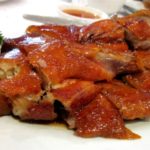Comparing Chinese Sausage and Sausage

|
Chinese Sausage |
Sausage |
|
|
Ingredients |
Chinese sausage contains pork, pork fat, sugar, salt, flavoring agents… but Chinese sausage also includes pork casing, while sausage does not. |
The main ingredients of sausage are similar to Chinese sausage, including pork, pork fat, salt, and sugar. However, sausage does not contain pork casing. |
|
Flavor |
It has a rich, fatty flavor that those with lighter palates may not enjoy. |
Sausage has a milder, more balanced taste. Some varieties include corn or beans, adding a unique twist that appeals to a wider range of tastes. |
|
Color |
Chinese sausage is typically a bright or deep red color. |
Sausages are often brown, yellow, or light brown. |
|
Preparation |
Chinese sausage needs to be fried, stir-fried, grilled, or steamed before consumption. |
Sausage can be eaten straight from the package or cooked in various ways, offering more convenience and versatility. |
|
Price |
Chinese sausage is generally more expensive than sausage. |
Sausage is more affordable than Chinese sausage. |
Which Is Better: Chinese Sausage or Sausage?

While both products are nutrient-rich, they also contain high levels of fat, providing excessive energy, and are high in salt and preservatives. Consuming these products in moderation is key to maintaining a healthy diet. Overindulging can lead to weight gain and negatively impact cardiovascular health.
However, when comparing fat content, Chinese sausage contains approximately 55g of fat per 100g, while sausage contains only 26g of fat per 100g. If you’re watching your fat intake, sausage is the wiser choice.
Sausage offers the convenience of ready-to-eat varieties, making it an excellent option for a quick bite. Simply open the package and enjoy!
On the other hand, if you crave meat with a rich, fatty aroma, Chinese sausage is the way to go. Its unique flavor and texture make it a delightful treat.
Chinese sausage also makes a great gift option for family, friends, or colleagues. It’s a delicious and unique way to show your thoughtfulness.
For more insights:
We hope that this article has helped you understand the differences between Chinese sausage and sausage, enabling you to make an informed decision about which one suits your preferences. Feel free to share your thoughts and opinions with us in the comments section below.
References: vietnamnet.vn, suckhoenhi.vn
You may also enjoy reading:
Choosing Delicious and Safe Chinese Sausages for the Tet Holiday
Tet, the Vietnamese Lunar New Year, is just around the corner. As part of the festive meal, Chinese sausage is almost always included. However, it can be difficult to choose and buy the right one. In this article from the Cooking Tips section, we’ll be providing helpful tips on how to select and purchase fresh and delicious Chinese sausage for your Tet meal.



































